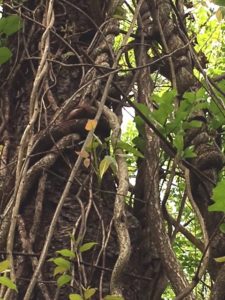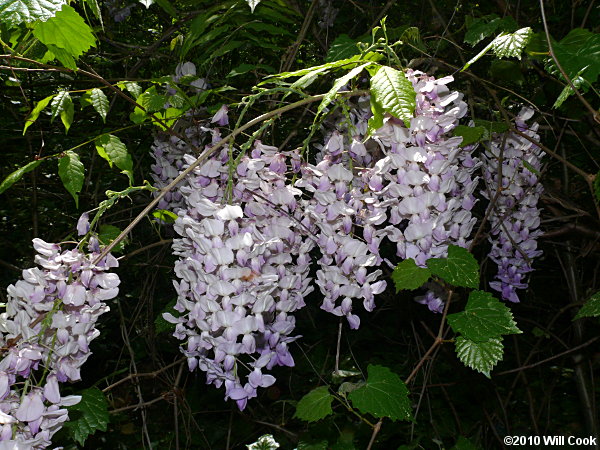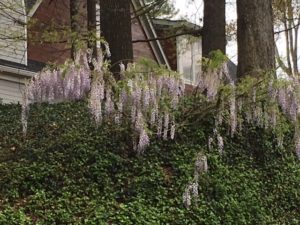 It was a dark and stormy night. The electricity was out again and I stood alone and shivering in the dark when I heard an unearthly sound coming from the back of the house. Between a gasp and a scream, it sounded as if someone – or something – was being strangled.
It was a dark and stormy night. The electricity was out again and I stood alone and shivering in the dark when I heard an unearthly sound coming from the back of the house. Between a gasp and a scream, it sounded as if someone – or something – was being strangled.
I put the leash on Sadie, who planted all four paws in protest. I convinced her to come out into the stormy night with me anyway and we half stumbled toward the sound. Sadie was rigid with fear and I wasn’t much better, but we had to find out what was making the noise.
When we reached the edge of the lawn, I shone my flashlight up into the trees and gasped with horror. The tell tale signs were there. Purple blossoms dripped off the limbs as the vine, like a long, slithering cobra, wrapped itself around the trunk and limbs of the closest trees. Dozens of tendrils seemed to be reaching out for us. I shuddered and Sadie hid her nose under my rainjacket. No doubt about it, wisteria “The Strangler” was loose among us…….

A little melodramatic? Well, maybe, but maybe not if you’ve ever tried to get rid of a healthy stand of wisteria. This (currently gorgeous) aggressive vine from China has acclimated to our American woods and has climbed and smothered many of our native trees and shrubs. Don’t believe me? Listen to this: There is a “Chinese lavender’ wisteria planted in 1894 in Sierra Madre, California that measures more than an acre and weighs 250 tons.!!!

Even the native American wisteria, Wisteria frutescens, can grow 40 feet and needs attentive pruning but it is not nearly as aggressive as the Chinese wisteria. It makes an excellent vine for arbors or trellises. One of the most popular cultivars is called ‘Amethyst Falls’ and is a highly satisfactory garden vine.

Controlling and / or getting rid of Chinese wisteria is a time consuming project. If you are determined to keep it in your garden, you’ll have to be diligent about pruning continually during the growing season.

If you want to get rid of it, dig up as much as you possibly can and be sure not to leave leaves, seed pods, stems or roots on the ground or they will take root. If you have to, you could consider painting the remaining stumps with an herbicide to help kill it completely.
If smothering, out of control growth was not scary enough, all parts of the wisteria vine are poisonous. I like almost all plants but there are some that I’d just as soon not invite home to my garden. “The Strangler” is one of them. Sadie agrees.
Happy Gardening!
Laura

Getting rid of wisteria is a lot like cutting a head off Hydra, you get two in return!
Botanist Thomas Nuttall named the genus Wisteria after an American anatomist, Dr. Caspar Wistar (1761-1818).
“Maturation can be forced by physically abusing the main trunk, root pruning, or drought stress.” That clearly equates with “no pain, no gain”!!! With wisteria, it’s obviously PROLIFIC gain!
Thank you, Laura, for your story.
Thanks so much for your comments Jane.